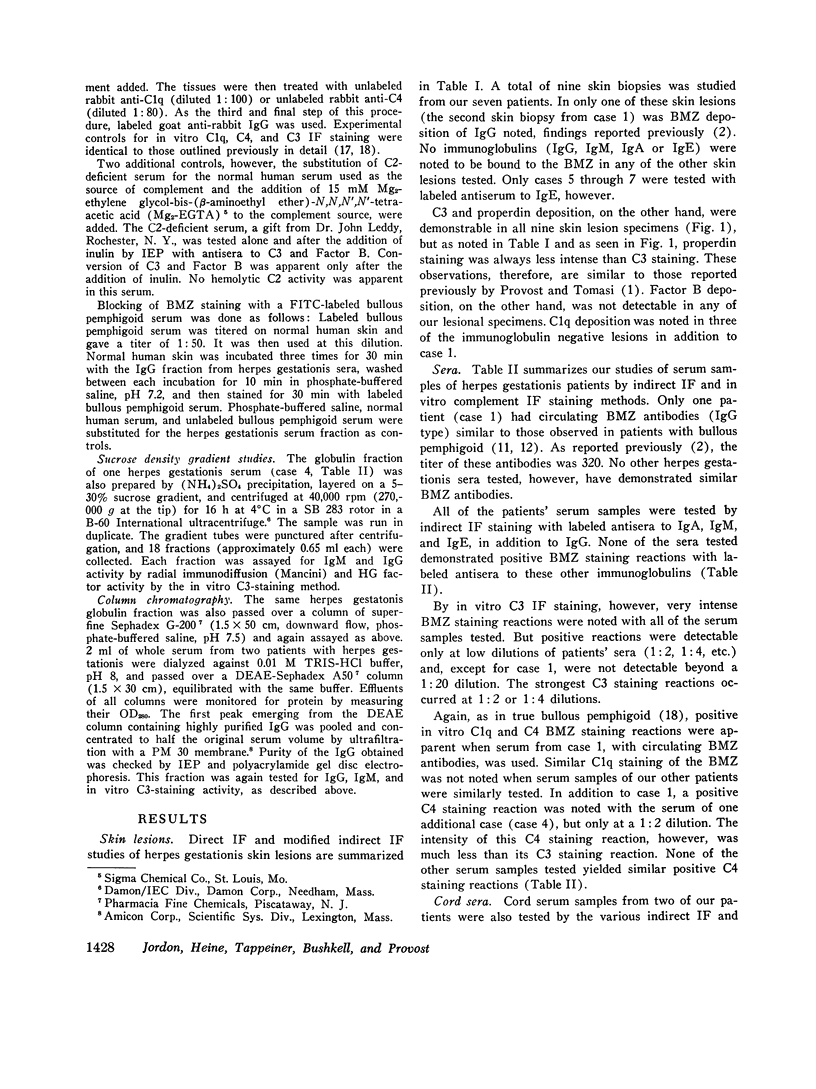Abstract
Nine skin biopsies from seven herpes gestationis patients were studied by immunofluorescence (IF) techniques. Basement membrane zone (BMZ) deposition of C3 and properdin was present in all nine skin specimens, while IgG deposition was apparent in only one. With in vitro C3 IF staining, positive BMZ staining (HG factor activity) was noted with all seven of our patients' serum samples tested. By standard indirect IF staining, however, only one of these serum samples contained BMZ antibodies of the IgG type. Two cord serum samples, tested by these same methods, yielded positive in vitro C3 staining (HG factor activity) but negative indirect IF staining (IgG). HG factor activity was found to be stable at 56 degrees C for 30 min and in two of three specimens at 56 degrees C for 1 h. Treatment of the complement source (normal human serum) used in the in vitro C3 staining assay with Mg2-EGTA or use of C2-deficient serum as the complement source inhibited HG factor activity. HG factor blocked the specific staining of the BMZ of normal human skin by labeled bullous pemphigoid antibodies. By sucrose density gradient ultracentrifugation and gel chromatography (Sephadex G-200), HG factor activity eluted with IgG-containing fractions. The highly purified IgG fraction of two herpes gestationis sera was also positive for HG factor activity. Our studies suggest that HG factor is an IgG antibody that may not be demonstrable by conventional IF methods, but which activates the classical complement pathway.
Full text
PDF







Images in this article
Selected References
These references are in PubMed. This may not be the complete list of references from this article.
- Bushkell L. L., Jordon R. E., Goltz R. W. Herpes gestationis. New immunologic findings. Arch Dermatol. 1974 Jul;110(1):65–69. [PubMed] [Google Scholar]
- DAVIS B. J. DISC ELECTROPHORESIS. II. METHOD AND APPLICATION TO HUMAN SERUM PROTEINS. Ann N Y Acad Sci. 1964 Dec 28;121:404–427. doi: 10.1111/j.1749-6632.1964.tb14213.x. [DOI] [PubMed] [Google Scholar]
- Ensky J., Hinz C. F., Jr, Todd E. W., Wedgwood R. J., Boyer J. T., Lepow I. H. Properties of highly purified human properdin. J Immunol. 1968 Jan;100(1):142–158. [PubMed] [Google Scholar]
- Fearon D. T., Austen K. F. Properdin: binding to C3b and stabilization of the C3b-dependent C3 convertase. J Exp Med. 1975 Oct 1;142(4):856–863. doi: 10.1084/jem.142.4.856. [DOI] [PMC free article] [PubMed] [Google Scholar]
- Götze O., Müller-Eberhard H. J. The C3-activator system: an alternate pathway of complement activation. J Exp Med. 1971 Sep 1;134(3 Pt 2):90s–108s. [PubMed] [Google Scholar]
- Hartree E. F. Determination of protein: a modification of the Lowry method that gives a linear photometric response. Anal Biochem. 1972 Aug;48(2):422–427. doi: 10.1016/0003-2697(72)90094-2. [DOI] [PubMed] [Google Scholar]
- Jablonska S., Chorzelski T. P., Beutner E. H., Maciejowska E., Rzesa G. Immunologic phenomena in herpes gestationis. Arch Dermatol Forsch. 1975 Jul 18;252(4):267–274. doi: 10.1007/BF00560366. [DOI] [PubMed] [Google Scholar]
- Jordon R. E., Beutner E. H., Witebsky E., Blumental G., Hale W. L., Lever W. F. Basement zone antibodies in bullous pemphigoid. JAMA. 1967 May 29;200(9):751–756. [PubMed] [Google Scholar]
- Jordon R. E., Nordby J. M., Milstein H. The complement system in bullous pemphigoid. III. Fixation of C1q and C4 by pemphigoid antibody. J Lab Clin Med. 1975 Nov;86(5):733–740. [PubMed] [Google Scholar]
- Jordon R. E., Sams W. M., Jr, Beutner E. H. Complement immunofluorescent staining in bullous pemphigoid. J Lab Clin Med. 1969 Oct;74(4):548–556. [PubMed] [Google Scholar]
- Jordon R. E., Schroeter A. L., Good R. A., Day N. K. The complement system in bullous pemphigoid. II. Immunofluorescent evidence for both classical and alternate-pathway activation. Clin Immunol Immunopathol. 1975 Jan;3(3):307–314. doi: 10.1016/0090-1229(75)90017-3. [DOI] [PubMed] [Google Scholar]
- Kocsis M., Eeg T. L., Husby G., Rajka G. Immunofluorescence studies in herpes gestationis. Acta Derm Venereol. 1975;55(1):25–29. [PubMed] [Google Scholar]
- LOWRY O. H., ROSEBROUGH N. J., FARR A. L., RANDALL R. J. Protein measurement with the Folin phenol reagent. J Biol Chem. 1951 Nov;193(1):265–275. [PubMed] [Google Scholar]
- Mancini G., Carbonara A. O., Heremans J. F. Immunochemical quantitation of antigens by single radial immunodiffusion. Immunochemistry. 1965 Sep;2(3):235–254. doi: 10.1016/0019-2791(65)90004-2. [DOI] [PubMed] [Google Scholar]
- McLean R. H., Michael A. F. The immunoelectrophoretic pattern of properdin in fresh and aged human serum. Proc Soc Exp Biol Med. 1972 Nov;141(2):403–407. doi: 10.3181/00379727-141-36786. [DOI] [PubMed] [Google Scholar]
- ORNSTEIN L. DISC ELECTROPHORESIS. I. BACKGROUND AND THEORY. Ann N Y Acad Sci. 1964 Dec 28;121:321–349. doi: 10.1111/j.1749-6632.1964.tb14207.x. [DOI] [PubMed] [Google Scholar]
- Provost T. T., Tomasi T. B., Jr Evidence for complement activation via the alternate pathway in skin diseases, I. Herpes gestationis, systemic lupus erythematosus, and bullous pemphigoid. J Clin Invest. 1973 Jul;52(7):1779–1787. doi: 10.1172/JCI107359. [DOI] [PMC free article] [PubMed] [Google Scholar]
- SCHEIDEGGER J. J. Une micro-méthode de l'immuno-electrophorèse. Int Arch Allergy Appl Immunol. 1955;7(2):103–110. [PubMed] [Google Scholar]
- Schreiber R. D., Medicus R. G., Gïtze O., Müller-Eberhard H. J. Properdin- and nephritic factor-dependent C3 convertases: requirement of native C3 for enzyme formation and the function of bound C3b as properdin receptor. J Exp Med. 1975 Sep 1;142(3):760–772. doi: 10.1084/jem.142.3.760. [DOI] [PMC free article] [PubMed] [Google Scholar]




